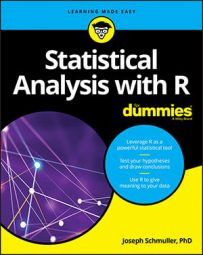length() is the R function that calculates this number. Work with the Cars93 data frame, which is in the MASS package. (Click the check box next to MASS on the Packages tab.)Cars93 holds data on 27 variables for 93 cars available in 1993. What happens when you apply length() to the data frame?
> length(Cars93)
[1] 27
So length() returns the number of variables in the data frame. The function ncol() does the same thing:
> ncol(Cars93)
[1] 27
You already know the number of cases (rows) in the data frame, but if you had to find that number, nrow() would get it done:
> nrow(Cars93)
[1] 93
If you want to know how many cases in the data frame meet a particular condition — like how many cars originated in the USA — you have to take into account the way R treats conditions: R attaches the label "TRUE" to cases that meet a condition, and "FALSE" to cases that don't. Also, R assigns the value 1 to "TRUE" and 0 to "FALSE."
To count the number of USA-originated cars, then, you state the condition and then add up all the 1s:
> sum(Cars93$Origin == "USA")
[1] 48
To count the number of non-USA cars in the data frame, you can change the condition to "non-USA", of course, or you can use != — the "not equal to" operator:
> sum(Cars93$Origin != "USA")
[1] 45
More complex conditions are possible. For the number of 4-cylinder USA cars:
> sum(Cars93$Origin == "USA" & Cars93$Cylinders == 4)
[1] 22
Or, if you prefer no $-signs:
> with(Cars93, sum(Origin == "USA" & Cylinders == 4))
[1] 22
To calculate the number of elements in a vector, length(), as you may have read earlier, is the function to use. Here is a vector of horsepowers for 4-cylinder USA cars:
> Horsepower.USA.Four <- Cars93$Horsepower[Origin ==
"USA" & Cylinders == 4]
and here's the number of horsepower values in that vector:
> length(Horsepower.USA.Four)
[1] 22

